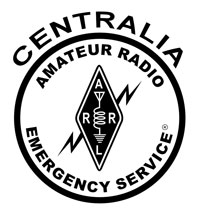
Setting up a landing zone for a medical helicopter evacuation is harder than it appears at first glance. You would think it would be simple: find a open, flat field and tell the helicopter pilot where it is! But it is so much more if every landing and takeoff is to be made safely. The Centralia ARES team gathered, at our June 4th meeting, for its annual landing zone training, staging at the Mt. View Baptist Church to review the procedures from our field resource manuals, then it was out to one of our designated landing zones in the north end of the city.
We discussed how Airlift Northwest would be requested and talked about selecting the appropriate landing zone, knowing it might be a pre-established LZ, an open field, parking lot or even a roadway. Once our communications van was placed, we moved on to preparing the landing area. A 100′ x 100′ LZ was set up with orange cones at all four corners with two more indicating prevailing wind direction and placed flashing beacon lights on each cone. Team members were then tasked with determining the latitude and longitude at the field’s center and conducting a group foreign object debris search of the landing area. Each person prepared a written communications briefing for the pilot that would include wind direction, overhead obstructions, and landing zone description.
Requiring the most time, of course, was the safety briefing. Helicopters are dangerous and working around them in any capacity requires knowing the safety rules. We discussed eye and ear protection, proper clothing, where to stand and required each team member to have an escape plan in case of aircraft failure. Knowing how to “wave-off” the helicopter if the landing zone becomes dangerous created more discussion. Once the aircraft is on the ground, team members are not allowed to approach until the blades have stopped turning and the helicopter crew waves us in. In fact, during a real evacuation, we may not approach the aircraft at all, leaving patient transfer to the aid crews.
While the ARES team would not be responsible for patient transfer or medical aid, we would be responsible for conducting a safe approach, landing and the later takeoff once the patient was on board. This requires constant communications with the pilot, normally done on the Riverside Fire Authority’s Rednet or V-Tac-11 interoperability frequencies. This evening we substituted an amateur radio simplex frequency for communications. While each team member created his own pilot briefing, our two newest team members Jay, KI7WLI and John, KI7YEF, were selected to give the briefing, with the communications van substituting as an approaching aircraft. Both did a great job.
After cleaning up the equipment and some final discussion, it was time to return the communications van and go home. For our team, a hands on exercise is important. The discussion over which way the wind was blowing was long and lively, and in the end we decided to call it “light and variable” to put an end to the arguments. While this exercise was conducted on our easiest and simplest landing zone, next time it gets harder as we practice the landing zone procedures in the tight confines of the downtown area.

